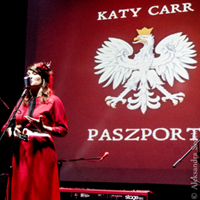
The Oleńka Dress, modeled by Oleńka herself
Photographed near Kraków’s Sukiennice
“I’ve always been in love with Polish history and folklore,” says Oleńka Lisiecka.
Born in the U.S., she’s spent half her life in Poland – every childhood summer, and later studying at the Jagiellonian and Lublin Catholic Universities, and living in Kraków post-college.
Last winter, she looked for souvenirs in Kraków to take back to her other hometown, Detroit, but felt like everything she saw didn’t fit her taste – especially the clothing.
She remembers thinking, “I wish somebody would make clothing that is modern and appeals to the younger generation.” That’s how she came up with the idea for her company, Recultured Designs.
She and her mother, Barbara, are co-owners. Oleńka designs the clothing; her mom sews.
“My mother comes from a long line of tailors, and my grandmother was a seamstress in Lublin,” Oleńka says. “She taught my mother everything.”
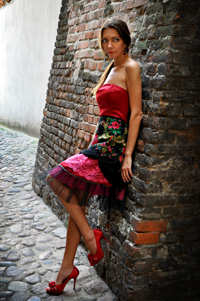
The Ania Dress
Photographed in Lublin’s Old Town
The first piece she designed and her mom sewed is called the Ania dress.
Oleńka wanted the dress to be noticeably Polish; the patterned material is called szlak góralski (mountain pass), she explains, and is used in Polish Highlander folk costumes.
To make the dress, Oleńka used a vintage red dress (“We refashion clothes often”) that she cut up and made strapless. She then added Polish material along with lace and lots of tulle. “It has 6-7 layers to it,” she says.
The photo was taken in Lublin’s Old Town, and the model’s name is Ania, like the dress. “I’m glad that my friends are so beautiful,” Oleńka laughs.
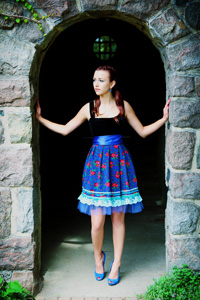
The Josephine Dress
Photographed in Cranbrook Park, Mich.
The Josephine dress is named after her grandmother, Józefa, and is the first dress her mom designed. It comes in a short and long version, and the model is Oleńka’s cousin, Kasia Lisiecka.
“She’s a Polish folk dancer, so she’s crazy about everything Polish.”
She also has a dress named after herself – the Oleńka, and that’s her in the photo (it’s at the top of this page). “I was pressured into taking some pictures,” she says, despite feeling shy about modeling. “I like to be behind the scenes.” She designed the dress to wear to a family wedding.
Each piece is handmade by Oleńka’s mother in their workshop, which also functions as a store – though the bulk of sales are online. Still, Oleńka says she encourages potential customers to stop by to try the clothes on in person. “I love seeing people try my stuff on,” she says.
Her design process often begins by finding a vintage dress in which she sees potential. “I start cutting it up, pinning it, and laying out materials on the dress,” she says, “then explaining to my mom how we have to take it apart and remake it.”
She likes the idea that her designs use existing materials: “There’s so many dresses out there, so many materials laying around that no one will ever use again.” Sometimes she’ll buy a dress and cut it up completely to use bits of the material on other pieces. “We’ll incorporate old vintage lace from one dress onto another. That’s also what makes it one of a kind. They don’t make lace like that anymore.”
She loves visiting estate sales – to find dresses she can remake – as well as vintage shops. But she also refashions contemporary clothing. If an outlet store is trying to sell out a line of skirts that didn’t sell at their regular stores, she’ll buy them and completely remake them, or use them for the material.
As for the Polish materials, she buys them in Nowy Targ, Poland. Most have Polish folk flowers, giving the designs she creates distinct Polish flavors.
She’s now working on a dress line inspired by Lublin folk costumes, which are highly ornamental, with ribbons and zigzags.
“It’s going to be very new and modern,” she says. “I sewed layers of tulle with different ribbons and zigzags on a very tight dress, and it ended up looking like a modern costume from Lublin.”
Her women’s line also includes purses, belts, aprons. The first product she ever made was a purse. She’d seen purses in Poland made out of Łowicz materials, and took down her father’s Łowicz tapestry and cut it up to make a purse. “I still don’t think he knows about it, “she says, then pauses. “I guess he will now.” She’s not sure if she’ll continue the purse line, as she finds clothing more rewarding.
The men’s collection is designed by her brother, Mikołaj.
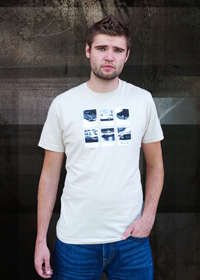
The “Classics” T-Shirt
The Classics T-shirt features photos of vintage Polish cars. “We have a Polonez on there, a Maluch,” she says.
According to her brother, the design is inspired by the idea of nostalgia, “a very powerful emotion as it can take us back to a happier, more carefree time.”
The Lotnik shirt, featuring blueprints of the Wellington bombers, was designed in memory of Oleńka and Mikołaj’s grandfather, Captain Navigator Wacław Lisiecki, who flew in a Polish Squadron with the Royal Air Force during WWII.
For Mikołaj, an important theme of Recultured Designs is taking meaningful things from the past and recreating them in original ways.
“We want these shirts to be more than just something that looks nice,” he writes me in an email. “We want our customers to feel something, to be left with an impression, whether it’s serious or light-hearted.” The military designs are a tribute to WWII veterans, but he also hopes his designs serve as a reminder of “the daily battles we fight in our lives.”
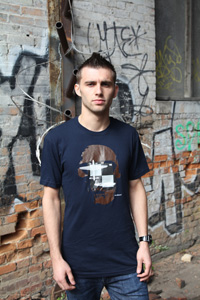
The “Lotnik” T-Shirt
Photographed in an abandoned Ford factory in Detroit, Mich.
Mikołaj’s interest in Poland’s military history traces back to his father, a book and war memorabilia collector. Mikołaj’s own love for design began during childhood, when he would pore over old uniform and weapon designs in their home library. “I remember being fascinated by the concept of honor, and how this idea exerted a great influence over the design of various military effects.”
Since Oleńka started her company in May 2012, she and her mom have produced ~80 dresses, ~50 shirts, ~60 skirts, ~50 aprons, ~60 purses. “My mom’s quick,” she says. Oleńka works at her company full-time, while her mom does it part-time in addition to owning a travel agency.
Oleńka wants to see her business expand here in the U.S. and in Poland.
She hopes to someday open a boutique in Kraków so that tourists will be able to enjoy a modern take on Polish culture.
But it’s also important to her that Polish-Americans and Americans wear her designs.
“I came up with this idea to inspire people to get in touch with their heritage,” she says. “I would really like it to be available in all the different Polish communities all over the U.S.,” but notes that she doesn’t think her designs are for Poles only. The idea of connecting Polish-Americans to their Polish heritage is, however, important to her: When she returned from Poland most recently, she found that many Polish-Americans around her weren’t in touch with their Polish side as she was. “I thought, what could get the younger generation more interested in their heritage?” She hopes that her products help do so.
When she wears her designs, she’s always asked about them. She tells people they’re inspired by Polish folk costumes, and also that she’s part Polish.
“It’s a good conversation starter,” she says.
Visit
Oleńka and her designs on Recultured Designs’ website
Imagery
All photos courtesy of Recultured Designs
